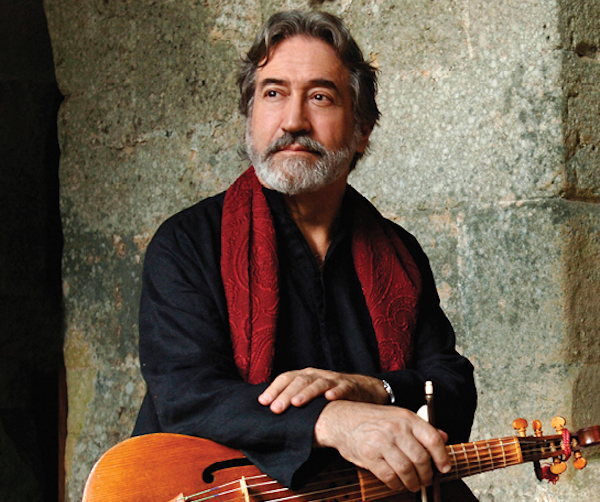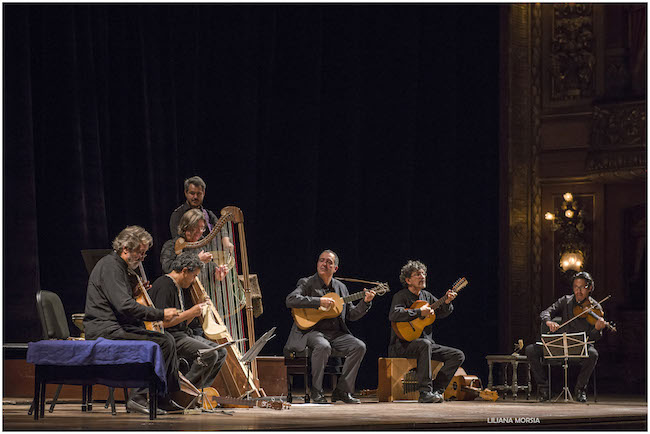Fuse Concert Review: Jordi Savall — Taking World Music for a Whirl
Rockport’s intimate Shalin Liu Concert Hall overlooks the ocean, but seemed to be transformed into a flamenco parlor in Seville.

Jordi Savall. Photo: Courtesy of Rockport Music.
By Susan Miron
Jordi Savall is the world’s most celebrated viol player, and his faithful admirers jam-pack his performances. His concerts — with whatever artists he chooses to perform with — are inevitably grand musical events, and Friday’s appearance at Rockport’s Shalin Liu Concert Hall was no exception.
With two members of his Hèsperion XXI (Xavier Diaz-Latorre, theorbo and guitar, and David Mayoral, percussion) and Tembembe Ensamble Continuo, Savall (7 string bass viola and treble viola, both made around 1500) presented “Folias, Antiguas and Criollas: From the Ancient to the New World.” Initially renowned for uncovering music from communities around the Mediterranean and presenting these works alongside music for royal courts and the church, Savall has recently deepened his interest in popular music for the Celtic viol. The resulting CDs and Scottish-based pieces in his concerts attest to his continuing interest in what is sometimes known as “world music.” You might think of Savall as a Catalan, viol-playing version of Yo-Yo Ma.
Formed in 1974 by Savall and his late wife, the amazing singer Montserrat Figueras, Hespèrion (from the Classical Greek word referring to people of the Italian and Iberian peninsulas) was one of three early music ensembles the pair founded. Famed for his scholarship in music of 16th and 17th century Spain, Savall is also renowned for its expert and liberal use of improvisation (which was deployed to brilliant effect in this concert). A quiet but deeply charismatic presence, Savall is credited with reinvigorating world-wide interest in medieval music and in the renaissance of the use of the viola da gamba. Winner of countless awards for his viol playing as well as conducting, he has made 160 recordings and even created his own label, Alia Vox. I have been to a half dozen of his concerts, and wouldn’t miss one within driving distance. They are events that expand — through uncommon music and musicianship — our aural landscapes.
The specialty of the Mexican folklore ensemble Tenebre Emsamble Continuo is Spanish baroque music, as well as the traditional music of Mexico and Latin America. Its three members — Ulises Martinez, Enrique Barona, and Leopoldo Novoa — sang and played a mind-boggling array of strange-looking instruments I had never heard of or seen before — guitarra huapanguera, Leona (a Baroque guitar), jarana jarocho, mosquito (a tiny guitar), pander, marimbol, haran huasteca, quijada de caballo, along with four sizes of guitars.
The collection was a feast for the eyes and ears! Rockport’s intimate Shalin Liu Concert Hall, overlooking the ocean, seemed to be transformed into a flamenco parlor in Seville. The music on the program’s first half, “Folios Antiguas,” were “follies” stemming from “La Folia,” one of the oldest remembered European musical themes, popularized during the baroque period. One selection seemed to melt seamlessly into the next. Remarkable guitar playing might follow a duet for theobo (a lute with a giraffe-like long neck), then singing for six would ensue. All the while each player approached his instrument as if he was a virtuoso jazz player, improvising with vigor. The experience was breathtaking.

Hesperion XXI & Tembembe Ensemble performing together. Photo: courtesy of Rockport Music.
Alternating between his two instruments, Savall and his five man band improvised while the other musicians elaborated, whipping up storms of delicious music. The ensemble drove on faster and faster, whirling and re-whirling the sound into the desired madness a ‘Folia’ would demand. Here and elsewhere the Hespèrion percussionist (at several points he played a huge, hundred-year old huge drum from Morocco) dazzled with is command of a number of instruments. (Savall always brings along fabulous percussionists.) The guitar playing throughout the evening was sensational; a palpable sense of joy emanated from the entire ensemble. Of the twenty possible tunings for his instrument, Savall explained that he used “The Bagpipe Tuning,” which crosses the fourth and fifth strings, enabling the gamba to evoke the wheezy drone of a bagpipe.
Part Two of this concert/jam session opened with “Celtic Traditions in the New World,” an exploration of the fertile connections and interactions among musical traditions, from Creole and Colonial-era to African and folk music from across South America. Several of the selections featured extraordinarily expressive viol playing; the tempo gradually became fast, then slowed up, then suddenly sped up to a loud frenzy, then slowed up again. Four strummed instruments made quite a lovely racket under some incredibly high notes from the treble viol. The scholarly program notes provided helpful background information, but even if a listener knew nothing about the history of the instruments or the music one would have had a wonderful time enjoying such brilliantly played music, whose chicanos, follies, canaries, járacas, and fandangos dazzlingly reflect the rich cultures of the indigenous peoples who initially encountered explorers and colonizers.
A haunting, anonymous Scottish funereal tune played as an encore provided the only dark moments in an otherwise effervescent and lively evening.
Susan Miron, a harpist, has been a book reviewer for over 20 years for a large variety of literary publications and newspapers. Her fields of expertise were East and Central European, Irish, and Israeli literature. Susan covers classical music for The Arts Fuse and The Boston Musical Intelligencer. She is part of the Celtic harp and storytelling duo A Bard’s Feast with renowned storyteller Norah Dooley and, until recently, played the Celtic harp at the Cancer Center at Newton Wellesley Hospital.

excellent review. looking forward to hearing them next time.